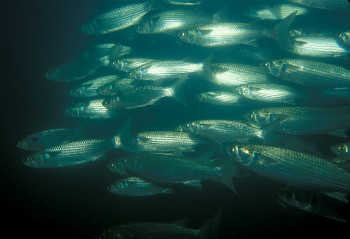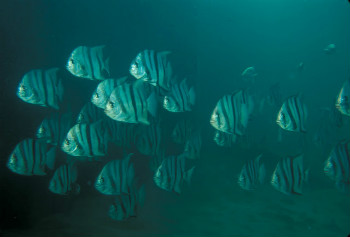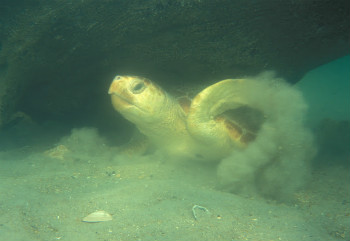BUXTON – Russell Blackwood was pointing to a photograph he had taken underwater of a juvenile flounder off Hatteras. Even close up, it barely looked like a fish , its shape completely covered with sand, pebbles and shells. Blackwood admired the creature’s camouflage skill.
“See him? There’s his little eyes. He’s looking back at me like ‘Why are you messing with me?’”
Supporter Spotlight
But the thing is, Blackwood wasn’t messing with him. With his camera in hand, the 57-year-old Buxton resident gets his kicks out of capturing sea creatures going about their business in their own environment, barely perturbed by his presence.
 Striped mullet in 15 feet of water on a shipwreck off Rodanthe. Photo: Russell Blackwood. |
 Spadefish school up in 10 feet of water at the jetties at the old site of the Cape Hatteras Lighthouse. Photo: Russell Blackwood. |

Sea turtles of every species use |
For more than 30 years, Blackwood has been freediving off the coast of Hatteras Island, where he has lived since 1975. He wears fins, a weight belt and a mask, maybe a wet suit, often carries a spear and almost always his camera. He used to be able to take one breath and stay under for two minutes at a time. Now it’s about one minute. He can go down as deep as 30 feet.
Silty and volatile, the Outer Banks’ waters rarely offer the opportunity.
Supporter Spotlight
“You can only scuba dive Cape Hatteras 10 percent of the year,” he said. “The shoals —- you can only do it 10 percent of that 10 percent because of the currents out there and the visibility.”
In 1981, Blackwood bought a Nikonos III, a 35mm underwater slide camera originally designed by Jacques Cousteau. Earlier, he had taken some underwater movies with a Super 8 film camera. Now he mainly uses a Nikonos V and can take impressive underwater closeups with a macro lens.
Blackwood has seen a big, old loggerhead turtle scraping barnacles off its back on a submerged oak tree. He’s seen thousands of blue crabs congregating by the jetty in Buxton and a nurse shark at the old Cape Hatteras Lighthouse jetty. His camera has recorded marine hitchhikers — shrimp on a jellyfish, shark-sucker remoras on spadefish — and the symbiotic food-hunting relationship between stingrays and cobia. He caught a shot of a deadly Portuguese Man-O-War jellyfish, its tentacles trailing in the crystal blue Gulf Stream water.
Many images were taken on or above various wrecks where fish congregate.
“There’s all kinds of debris around here and nobody knows about it,” Blackwood said. “It gets covered and uncovered and covered and uncovered again.”
Blackwood says he’s respectful of sea creatures, and in turn, they’re respectful of him. He approaches slowly, or just waits. He consciously slows his heartbeat. As his photographs reveal, one way or another, he has managed to be close.
“Marine life can feel your anxiety under water,” he said. “You have to put a passive vibration on under water.”
One shot of a barracuda swimming toward Blackwood shows its face, its expression menacing and angry. Not so, Blackwood said.
“He’s breathing, that’s all he’s doing,” he said matter-of-factly.
But there was that time he had speared a fish and a passing barracuda decided to help itself to some easy dinner, getting a little closer than he would prefer.
“When he was biting into that African pompano, you could hear his teeth chomping on the spear,” Blackwood recalled, laughing.
Blackwood sounds a bit like Jack Nicholson when he talks, with a seemingly calm voice edged with a restless, slightly unhinged, intensity. He laughs a lot, often at himself. Leaning back casually on his sofa, wearing jeans and a blue T-shirt, his hair with the bleached blond streaks of someone who spends a lot of time outside in the sun, he looks and acts like a younger man.
He has been married to the same woman, Heidi, for 30 years and has a 16-year-old son, Wolfie. Both sometimes dive with him.
Time, and freediving, he says, have been good teachers. And fortunately, he added, he’s allergic to alcohol.
“I used to be an angry bastard,” he said. “I just got old. That’s the thing about freediving. It’s learning how to calm yourself.”
Because he needs no no tanks or breathing devices, Blackwood can hear the sonar of the Atlantic spotted dolphin and their clicks and chirps. He can feel their sonar going through his body.
“You’re able to be quiet under water,” he said.
He prefers to dive alone, although he acknowledges it could be dangerous if something happened.
Some people, he said, have accused Blackwood of somehow drawing the fish toward him, a notion he scoffs at. “Marine life, they dictate how close you get up to them,” he said.
He has had a turtle “as big as this sofa” try to mate with him. One time, after a charter boat mistakenly left him alone in the ocean for about 45 minutes, he ended up swimming with a pod of dolphin, until one alpha male decided he’d had enough and hit Blackwood on the head with his tail.
 Find the flounder. This juvenile southern flounder blends with the shell fragments on the bottom of a sandbar in six feet of water at Cape Point. Photo: Russell Blackwood. |
His most amazing experience was years ago when he was working on a dive boat off Cape Point, on a rare day when the water was crystal clear. Hundreds of sand tiger sharks were on a wreck. Diving off the bow of the boat, he went down about 30 feet, and out of nowhere, he was looking right at a juvenile Great White shark, the biggest shark he’d ever seen. Stunned, he ever-so-slowly swam back to the boat.
“See this is the thing about people who don’t dive and don’t spend a lot of time in the water,” he said. “You’re only seeing these sharks when they’re caught in a net, or chasing them on the surface. You’re only seeing them in a state of panic.”
The No. 1 question, he said, people ask him is “Aren’t you afraid of sharks?” His retort is he knows how to deal with the ocean sharks – they’re actually quite skittish – it’s the “land sharks” that he finds threatening.
Born in Newport News, Blackwood grew up in Ahoskie and Hampton, Va., and said he was always drawn to the water. As a teenager, he attended Hardgrave Military Academy in the mountains of Virginia, an experience that reinforced his desire to be on the coast – “My gills got dry,” he says. After coming to Hatteras Island in the ‘70s, he made a living working in restaurants and commercial fishing. And in between, he caught waves.
“That’s why I moved here – to surf and to be near the ocean,” he said. “Then I kind of supplemented my diet with pole spearing.”
Blackwood said spearfishing is more sportsmanlike than other fishing, and he only kills enough to eat. He does not own his own boat and never did.
“The thing about spearfishing is you can go spearfishing and not shoot anything, but you can have an unreal day just diving.”
For the past 20 years, Blackwood has given slideshows and lectures at the Dare County schools to make young people aware of what’s off their coast. It amazes him that many of the island kids don’t even know how to swim and complain about having nothing to do.
“It’s opening up their minds,” he said about his presentations. “Just where they live, how lucky they are to be here. There’s people who live on this island and don’t even go to the beach.”
Most of what Blackwood has done has been self-taught – he never went to college. Over the years he’s owned a seafood restaurant, worked as a videographer and photographer for several movie and television productions, been an observer for Duke University Marine Lab, mated on a dive boat and done carpentry work – he built the blue cedar shake saltbox house where he and his family live in Buxton.
He published Ocean Outerbanks, a book featuring his underwater photography, in 2004 and maintains a blog site of the same name. Freelance work for a French spearfishing company and a Chapel Hill company is being planned. His near-term goal is to get into digital video work.
“I’m not that much of an over-achiever,” he said. “I’m not that much of a money man. You can’t just do one thing and boo-hoo when it fails.”
Since he has lived on Hatteras Island, he has seen how financial excess can ruin people, and he said he wants nothing to do with it.
“We got addicted to money,” he said, shaking his head. “Luckily, I never had that problem. Making money – it’s like drinking saltwater on a life raft. Once you do it, you can’t stop. It’s addictive. I’ve got dozens and dozens of friends who are millionaires and all they think about is making money. Because I’m not stuck in one job and hate my job, you’re labeled as non-ambitious.”
Every year, he takes off for a month or so to isolated areas of Baja or South Australia – on the edge of the desert – to dive, surf, spearfish and, always, shoot underwater pictures.
“With photography, I don’t think about the cool photographs I’ve taken,” he said. “I think about the cool photographs I’ve missed.”








